How To Make Money With ChatGPT (AI Guide for 2024)

AI chatbots or virtual assistants have been around for quite some time now—but in most cases, these little bots were primarily customer service helpers on business websites and apps.
However, since the introduction of ChatGPT in November 2022, people have discovered just how useful (and fun) it is to interact with a natural language model of artificial intelligence.
Many people find the ability to ask any question and get an intelligent answer attractive, and naturally, people have started seeking opportunities to make money using this powerful platform. The search term “make money with ChatGPT” hit an all-time high in March 2023, according to Google Trends:
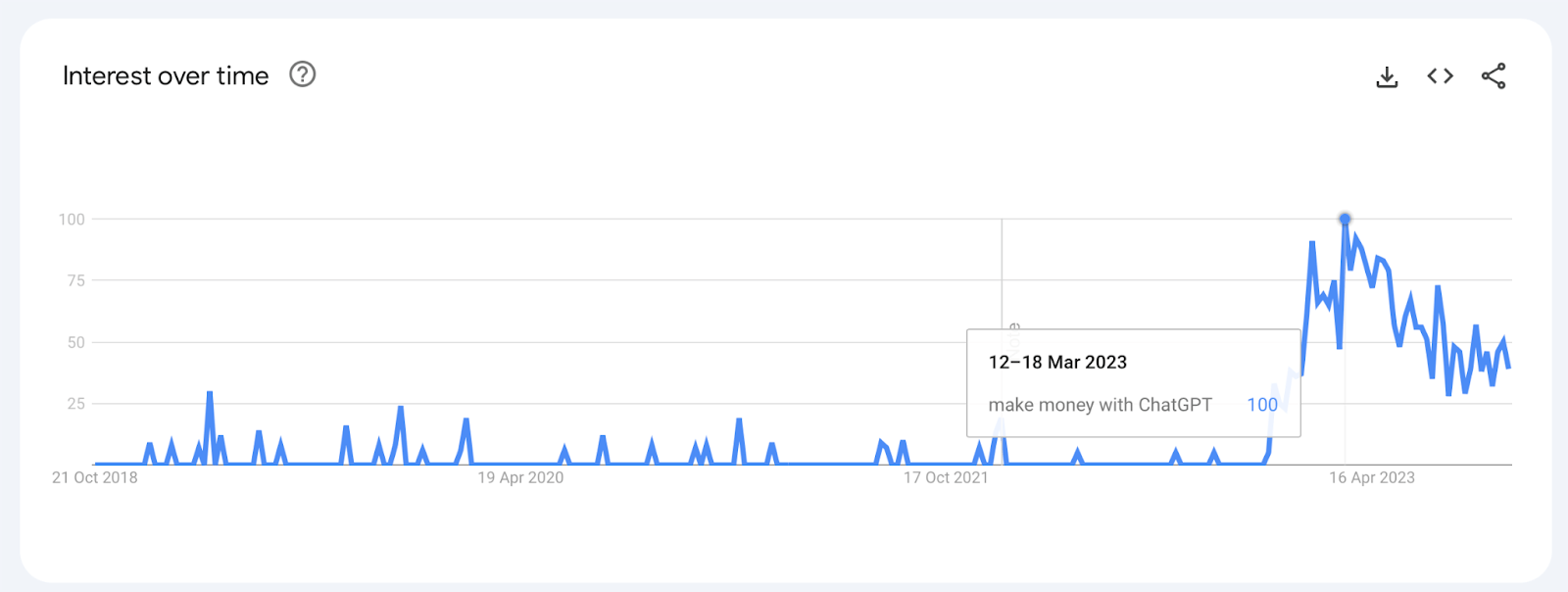
In this article, we’ll cover the top ways to make money online with ChatGPT so you can choose the best one for your needs.
Before we dive in, it’s important to note that none of these methods are genuinely considered “passive income”. No matter what you choose, you still need to direct ChatGPT with precise prompts and give it human oversight to ensure it’s doing what you want correctly.
Another noteworthy aspect is that you’ll get better responses from ChatGPT-4 compared to GPT-3 (or 3.5). If you want to get serious about using the tech, it could be worth springing the extra cash for the latest version.
8 methods of making money with ChatGPT
So here’s the list—with each method, I’ll explain the overall approach, then give tips on how to start making money with it and succeed in the long term.
1. Offer consulting services
If you know your way around GPT (short for generative pre-training transformer), offering consulting services is one of the best ways to make money.
- ChatGPT consulting. With this approach, you can provide in-depth advice for clients needing help integrating ChatGPT into their business or needing specialized training on how to use it effectively. As a consultant, you should have strong knowledge of the technology and the different types of software and applications associated with it.
This way, you can offer helpful insight to potential customers.
- API integration consulting. This method is slightly simpler because you only need to pitch consulting services around ChatGPT API integration. For example, let’s imagine your consulting niche is small e-commerce stores. You can consult with your clients on implementing a ChatGPT API to build a chatbot messenger or for CRM data extraction.
The best part about ChatGPT consulting is that even if you get stuck with a question you’re not sure of, you can ask ChatGPT yourself for step-by-step guidance on the problem you (or the business you’re consulting) are facing.
The main issue with this method is that it’s now highly competitive—the term “ChatGPT API integration consulting” returns over 1.2 million results on Google.
So, to make real money as a ChatGPT consultant, you’ll need to make sure the website that advertises your services uses search engine optimization (SEO) best practices, that you develop topical authority (using blog posts and social media posts), and you’re familiar with digital marketing strategies to help build up your business.
2. Create online courses or tutorials
Let’s say you are already an expert in something—that’s pretty cool, and chances are, someone out there in the world wants to learn how to do it, too. Over 100 million students worldwide are enrolled in online courses, and the interest in online courses grows yearly.
When it comes to creating courses or one-off tutorials, you can use ChatGPT to help you build an outline or syllabus. Then, if you break it down further—with the help of ChatGPT—you can write the script or text for each lesson. Let’s say, for example, I wanted to teach beginners about building a blog and monetizing it.
Using a specific prompt indicating the education level I wanted to teach, ChatGPT generated a 10-unit course for beginners. ChatGPT-4 even recommended optional add-ons for upselling:
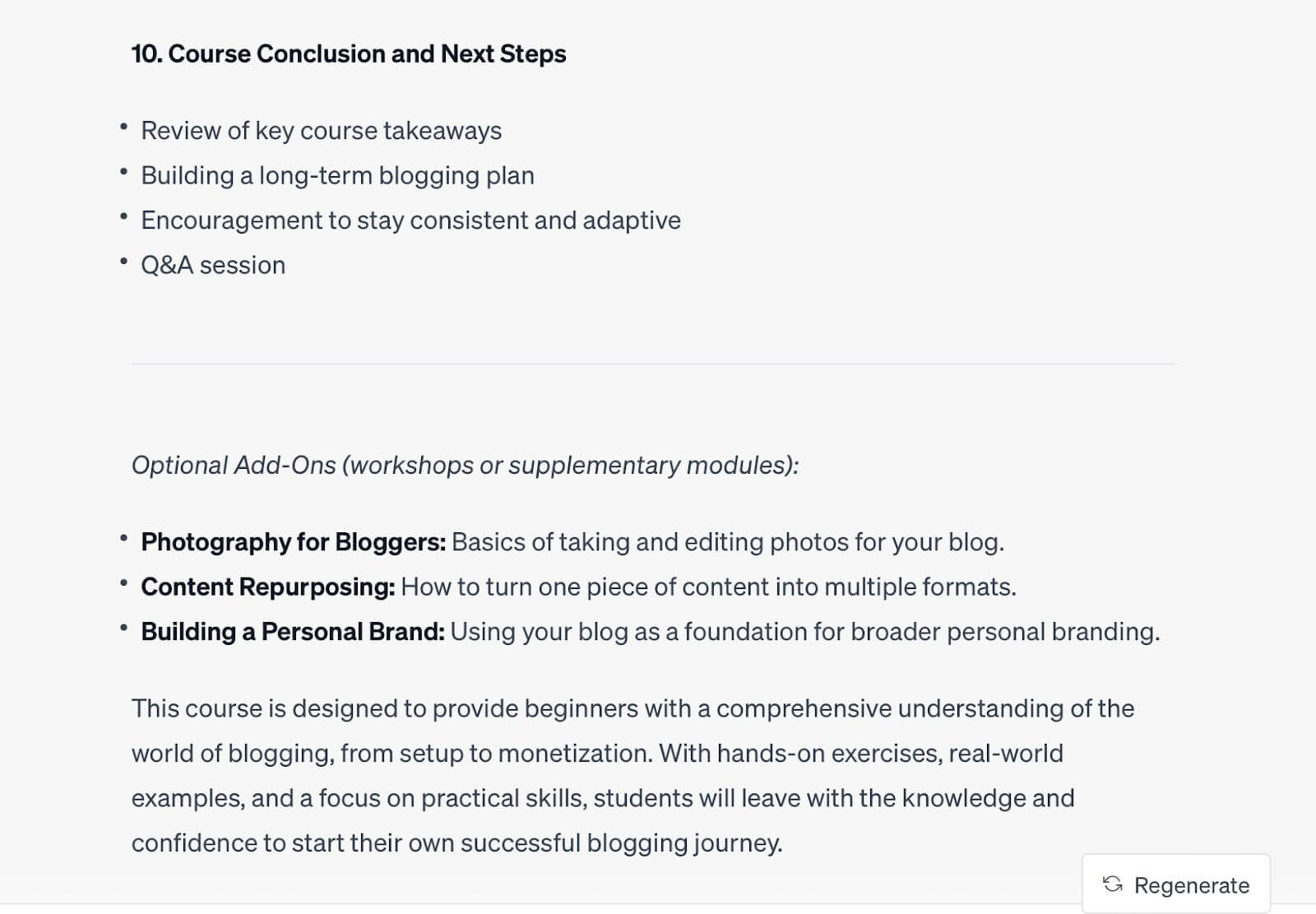
As I mentioned before, it’s important that you’re already an expert in the topic you want to teach. This way, you can use your knowledge to verify the topics that ChatGPT suggests you cover and make sure they will actually be useful for your students.
While ChatGPT can help you build the course, it’s generally up to you to find a platform you want to host your course on and to find students who will pay. Some popular course platforms include:
- Coursera
- Udemy
- Skillshare
- Thinkific
- Teachable
- edX
Each of these platforms has its pros and cons—but for the most part, using an established e-learning platform saves you time on having to build a website to host your course and on getting traffic.
On top of that, you’ll also have access to their built-in bank of students who are ready to learn—instead of doing all that marketing to reach your target audience yourself (although some marketing wouldn’t hurt even if you do use an existing platform).
3. Offer remote services
While consulting could technically fall under the “remote services” category, I made the distinction between them since consulting about ChatGPT is a little different from using ChatGPT as part of the service you perform.
Naturally, there are pretty much endless opportunities for the types of remote services you can provide. But for this article, I’ll just cover the options that take less effort to get started.
In all of the following services, you can sign up for a remote work service platform such as Fiverr or Upwork to help you get started. However, once you’re more confident in your service offerings, you can move off of these platforms (as their fees make it difficult to be truly sustainable long-term) and build a business website where you can manage inquiries and display your services.
Prompt engineering
If you’re particularly good at getting the best AI-generated responses from ChatGPT, chances are you’ve got skill in making ChatGPT prompts. Prompt engineering is a new career field where people get paid to design and optimize GPT prompts for various uses.
The good news is that since ChatGPT is still quite new, lots of people still don’t know how to maximize its usefulness and will pay others to do it for them. However, the less great news is that because the field is so new, it can be hard to show both its value and your expertise.
Build a portfolio that compares well-crafted prompts with poorly crafted prompts to illustrate the value of expert prompt engineering. In addition, case studies can highlight the tangible benefits and improved outcomes achieved through optimized prompts, providing potential clients with a clear insight into how professional prompt design impacts content.
Bulk product description writing
Some e-commerce stores can have hundreds or even thousands of products available on their websites, and someone has to write the descriptions for those products. Simply set up your profile on Fiverr or Upwork and offer product description writing services.
Using ChatGPT, you can generate great product descriptions in a matter of minutes—as long as you spend a little bit of effort designing the prompt to get the best results, i.e., be as specific as you can, here’s an example:
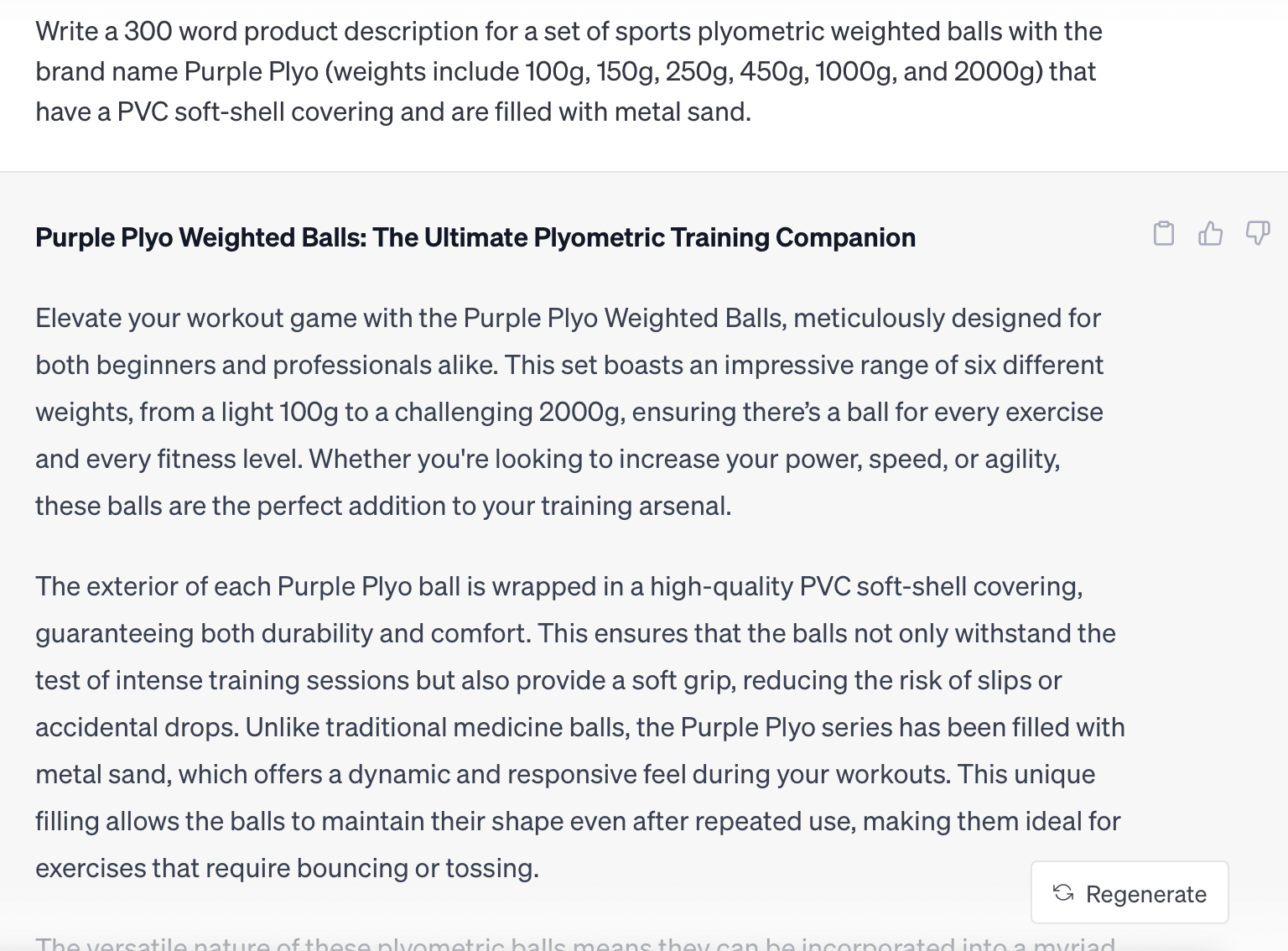
Notice I’ve included the (fictional) brand name of the product, its specifications, and materials. A clear, specific prompt ensures that the description accurately represents the product.
Ambiguity or generic prompts can result in descriptions that are off-brand or even misleading. For instance, there’s a vast difference between “a blue shirt” and “a navy-blue, men’s slim-fit shirt made from 100% organic cotton.”
Content strategy
If ChatGPT was only known for being good at one thing, it’d be generating ideas. From AI business ideas and content ideas to content strategy ideas. ChatGPT is a brainstorming powerhouse. As a result, you can use ChatGPT to help you offer content strategy services.
As an aside, for this particular service, it’s extremely helpful to have a good foundational knowledge of content strategy before offering it as a service (even with ChatGPT’s help).
The purpose of using ChatGPT, in this case, is to help speed up the process of building a content strategy and therefore offer your services to more clients than you could without it.
For example, you can use AI to help you create a strategy outline (e.g., defining the audience, target keywords/content pillars, content creation, distribution, and promotion), but then using your knowledge, you can fill in the blanks.
Alternatively, you could use an extensively-detailed prompt as a task brief and simply edit what comes out. With either method, you can use ChatGPT to help you develop a high-quality content strategy for your clients.
As a tip, it’s always worth testing various prompts to see how your wording impacts the response. Once you settle on a prompt that gives good results, try to use it to create a template prompt to save you even more time.
Freelance writing or editing
Since ChatGPT has been around long enough for companies and individuals to experiment with it—the overall conclusion at the moment is that ChatGPT can’t write high-quality content on its own. Readers can also generally tell when something was written by ChatGPT, which in turn diminishes the perceived quality of the content.
So, what do you do if you want to use ChatGPT for freelance copywriting or content writing services? You can still offer AI-written content to businesses that want it—again, if you develop your prompt engineering skills, you can promote this as added value.
However, another option that seems to be picking up in popularity is offering a service for editing and improving upon AI-written content. So, if you enjoy working from a draft, this could be a great option for you.
Logo making with DALL-E3
Finally, if you have access to ChatGPT-4, as of October 2023, you can use DALL-E to generate AI images. For the time being, AI-generated logos can have some “interesting” results and probably aren’t best to use for paid services (at least in their original forms).
However, remember how ChatGPT is an idea-generating boss? So, similarly to content strategy services, you can use ChatGPT to significantly speed up your design process by having it come up with initial ideas for you. For example:

I asked ChatGPT to “Design a logo for a time-tracking software named Clock’d designed to be used by remote service workers who charge for their services by the hour. The brand personality is cheeky and sarcastic but gets the job done when you need it.”
Its initial results definitely weren’t good, but then I refined the prompt by asking ChatGPT to make it more minimalist, and it gave the above responses (I quite like the third one). From there, you can take the idea to whichever designing tool you use, such as Canva or Photoshop, and improve it based on your client brief.
Notice how with each of these methods for remote services, you need to put in at least some effort to make the service you’re offering work. To ensure the long-term success of your business, make sure you follow these best practices:
- Establish yourself within an industry niche—you can change your niche later if you really want to, but it’ll help you attract the kind of clients you want to work with.
- Remember to do marketing for yourself (or your business). Otherwise, you run the risk of running out of work with no leads coming in. In this case, it’s often a good idea to find a particular marketing channel, e.g., email marketing, and stick with it.
- Treat your business like a business, even if you think it’s only a side hustle. This means having a separate business bank account, proper tax registration, and accounting services.
- Charge more as you gain more experience and add greater value to your services. Don’t stick to the same price for years.
Building a whole business isn’t the easiest task in the world, so you’ll need to be ready to commit to the effort. With or without the help of ChatGPT, building your own business can be one of the most rewarding experiences you’ll have.
4. Create HTML calculators
This is a fun method of using ChatGPT to make money—and out of all the other methods on this list, this one comes the closest to being “passive income.”
The basic overview of this method is using ChatGPT to generate the code you can use to create a calculator for people to use online. To get started, you’ll need
- A website where you can insert the calculator code—preferably one that you’ve built up around a particular niche in which your calculator would make sense. For example, a blog about personal finance can create a compound interest calculator to show people how investing/saving works over time.
- Good keyword research. Even if you do have a niche website, be sure to still do some keyword research to find a calculator idea that is relevant, high-volume, and low competition (the above example is quite high competition).
- ChatGPT (preferably GPT-4 as it’s better at generating code than older versions).
So, let’s take the above example and plug it into ChatGPT:
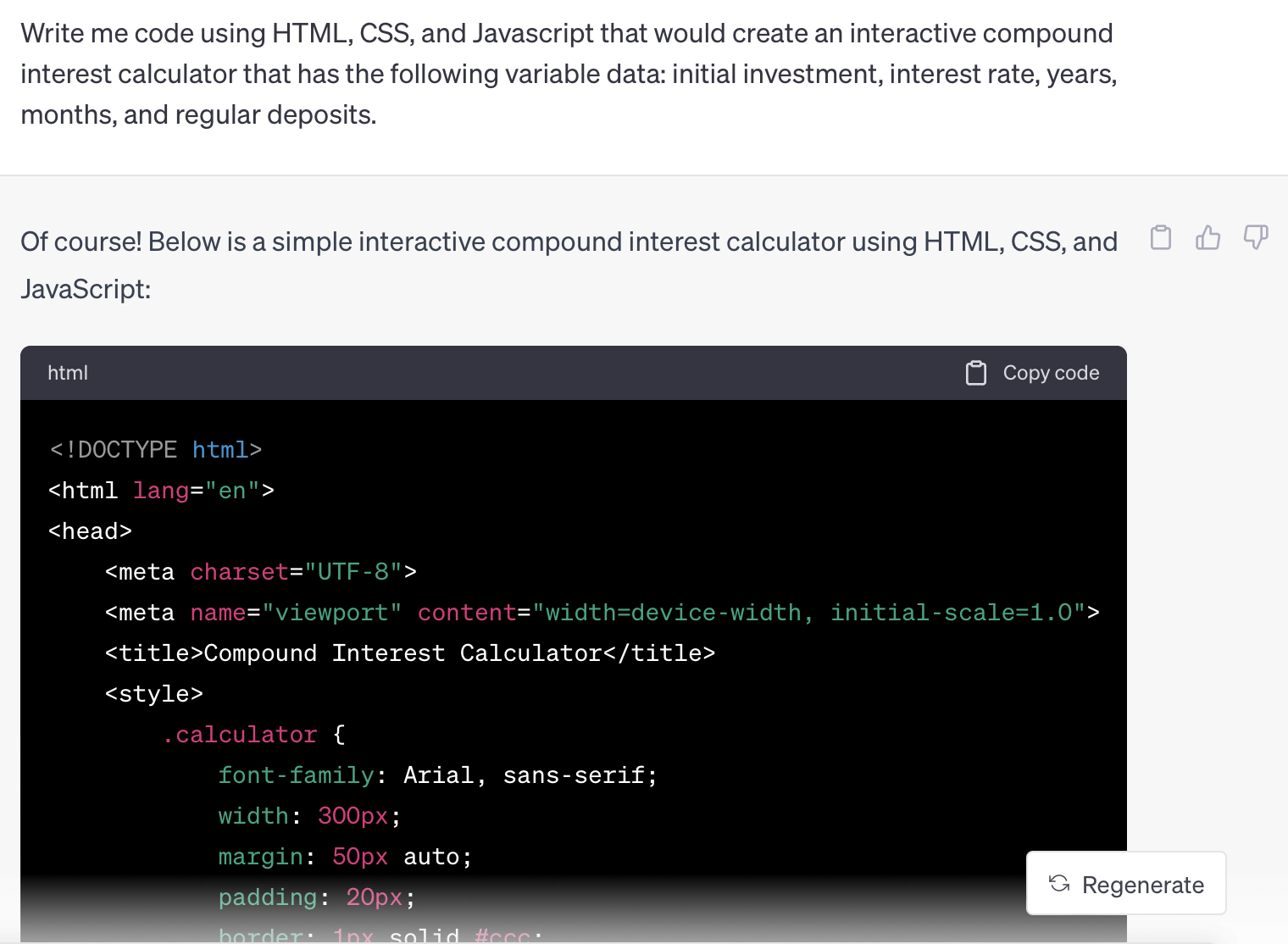
Of course, it’s helpful if you know the programming languages you ask ChatGPT to use so you can spot any errors in the code. Knowing the languages also helps you customize the code if, for example, you want to change the design or customize it.
However, let’s say you’ve done any necessary debugging and customization, and you put the calculator on your website. Now what?
To monetize this method, you can go two routes: affiliate links or ad traffic.
To determine which method you should use, try finding out if your calculator can reasonably link out to any products or services. The compound interest calculator example would work nicely as an affiliate page since the calculator can link out to recommended financial saving/investing products.
However, if it’s difficult to pinpoint a particular product or service for your calculator, (let’s say, for example, a square footage calculator), then you can use the high-volume traffic to your website and serve ads to your visitors.
The key to monetizing this method is the keyword research you do beforehand. Use a service such as Ahrefs or SEMrush to help you pinpoint a calculator that makes sense for your website.
5. Build a chatbot yourself
Remember how the first method I mentioned involved consulting with businesses and helping them build a chatbot for their business? Why not build a chatbot yourself and sell it to them? Small businesses pay between $3,000 to $5,000 for a simple sales chatbot, while some businesses spend hundreds of thousands of dollars building one internally.
Plenty of businesses that use chatbots for their customer services lead acquisitions, sales, and marketing in lots of different industries. Using ChatGPT’s massive natural language learning model API, you can create a chatbot that solves fairly complex queries much quicker than the chatbots of old.
In fact, if you’ve never built a chatbot before, you can even ask ChatGPT how to do it and follow the instructions it gives you. Of course, it’s extremely beneficial to have some prior coding knowledge before trying this method, as you may run into issues with code generated by ChatGPT or need to do some customizations for the business buying your chatbot.
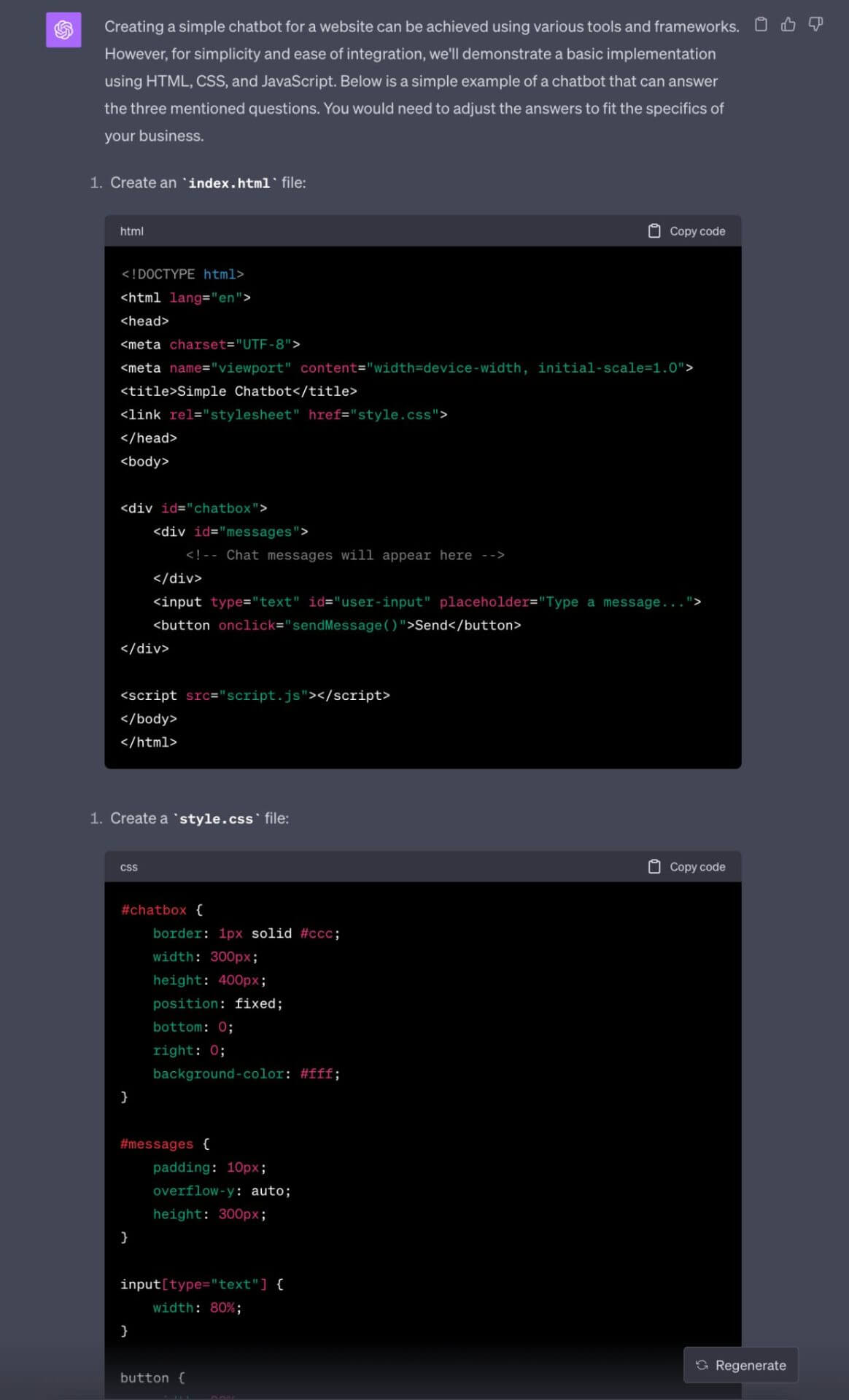
However, assuming you learn everything you can about building chatbots and have a few examples ready for pitching to businesses, here’s how you can monetize this method:
- You can sell your bot for a one-off flat fee—providing all the source code and some follow-up implementation support.
- Use a subscription model and charge a recurring fee for ongoing support, updates, and new features.
- Get paid on commission when the bot helps generate leads and sales.
Admittedly, this method isn’t going to be one for beginners, but if you’ve got the time and knowledge to invest, plenty of businesses will pay you for it.
6. Publish eBooks
The thing about publishing eBooks using ChatGPT is that it has the same caveats as offering freelance writing services. People can generally tell at this point when a content creator has used ChatGPT to make the content (when it’s unedited). On top of that, this method only works if you want to publish a non-fiction book.
So, if you want to publish a book, here are the steps you’ll need to take:
- Use ChatGPT to help you build a book outline based on what you want to write about. You should base your book on questions that your target audience needs answered.
- You can use ChatGPT to generate text in the body of the book, as long as you make the effort to edit the generated text based on how you would like it to sound and come across.
- You’ll need to use another software (such as Word or Amazon’s Kindle Create) to help you format the book, as well as another for designing the front and back cover.
- From there, you can use an online publishing platform like Amazon Kindle Direct Publishing (KDP) to list the book on Amazon Kindle and start getting buyers for your book.
There is one major aspect to book publishing you’ll need to consider before diving into this method—just making the book and publishing it won’t make you rich overnight. You need to be able to promote your book and build an audience of people who will be interested in it.
It’s for this reason many self-publishing authors don’t succeed—they don’t have a market for their book or a platform to promote it to before they’ve decided to write one.
So, if you’re planning a lengthy book, it’s worth generating a buzz for it online first by creating social media content to hype it up—TikTok video content, Instagram visuals, or LinkedIn summary/intro posts, for example, can help get people excited about your book before you publish it.
7. Become an affiliate marketer
One of the best methods of using ChatGPT to make money is to build a blog specifically for affiliate marketing.
ChatGPT can help you come up with ideas for finding your niche, building a brand, any custom code snippets you might want to add to your website (e.g., that HTML calculator I mentioned before), and for helping you with content ideas.
Many of the tips I’ve mentioned throughout this guide, particularly with using ChatGPT to make content strategies, will be useful if you decide to build an affiliate blog or website.
Of course, you’ll still need to use another service, such as Ahrefs, to do proper keyword research. But once you’ve got the up-to-date keyword research data, you can feed that into ChatGPT and have it come up with content ideas that will naturally blend with your affiliate programs. From there, ChatGPT can help you flesh out the ideas one at a time.
The key to making this strategy work is doing the necessary research upfront before heading to ChatGPT. However, just as an example, particular dog breeds make for great affiliate content—in this case, I’ll use the Chorkie (Chihuahua and Yorkshire Terrier mixed breed). As an overview, you can ask ChatGPT to create an affiliate blog content strategy based on the Chorkie dog breed (or insert your niche):
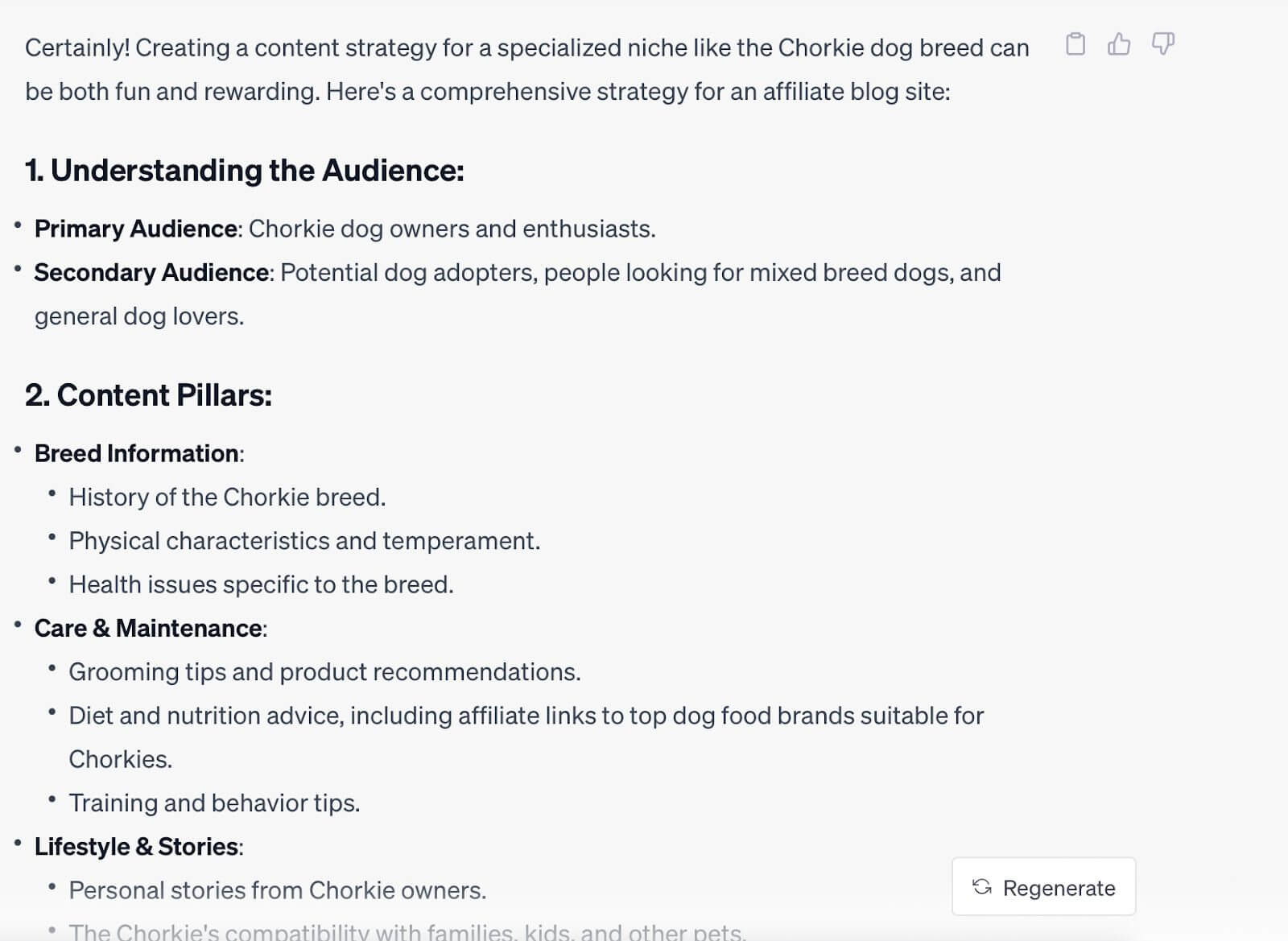
As you can see, ChatGPT gave me plenty of ideas to work with. From there, I can verify the target keywords using a keyword research tool, as well as looking at Google’s “People also ask” function to see if people are searching for the information I would provide on my blog (which, by the way, is a great opportunity for adding affiliate links to FAQs).
Once verified, the job is simple (in theory)—create the content and make sure you use opportunities to promote your affiliate links. Of course, content creation isn’t always simple, and it can take a long time before you see real results.
8. Build up a TikTok, YouTube channel, or podcast
The final method of how ChatGPT can make you money is by helping you build up a personal brand or platform on social media sites like TikTok or YouTube.
One tip here is that ChatGPT can’t really help you be authentic in your content—that’s all got to come from you. Using it for generating ideas for content that you can plan in advance is great, but using it to help you come up with “spontaneous” content is a bad idea since it won’t resonate well with your audience.
So, what are some more specific methods of using ChatGPT for building up a content platform?
- Faceless videos. While showing your face and giving direct eye contact in videos helps to build trust with your audience, not every type of video content lends itself to having a visible speaker.
Some types of topic presentation videos where there may be a lot of images or video clips to play, might make having an on-screen speaker distracting. However, faceless music videos are also very popular on YouTube and TikTok (for example, Dark Academia aesthetic-themed faceless videos are incredibly popular).
For these types of videos, you can have ChatGPT help you come up with ideas for the video content, write the script, and give you tips on what type of media to use.
- Video marketing strategy. As with creating an overall content marketing strategy, with ChatGPT, you can dig even deeper and have it create a video content marketing strategy.
To get more specific, ask ChatGPT to make a strategy based on the specific platform you use, your target audience, your niche, and even what equipment you use to help you build up an audience on your platform and earn money.
For monetizing this method, you can use a platform’s native monetization features, such as YouTube’s partner program or TikTok’s Creator Fund, relying on their respective platform algorithms. You can also utilize affiliate links and promote the links in your video descriptions or get a brand to sponsor your videos or podcasts if you have the right audience for them.
Start making money with ChatGPT today
Learning how to make money with ChatGPT is a great way to create content more efficiently and increase your earning potential. We’ve just scratched the surface of what ChatGPT can be trained to do—there are plenty of side hustles and full-time opportunities you can explore and take advantage of.
As AI tools become more advanced, businesses and individuals have access to an ever-expanding suite of tools that can help them make more money.
Further reading on AdamEnfroy.com:
Here are the best AI writing software to help you finish your writing projects faster.
You can also learn how to make money with AI art.





